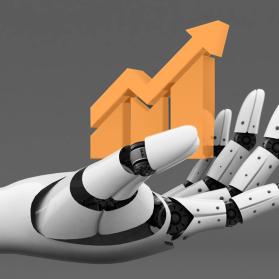Digital Finance, Finance Transformation, Finance 4.0 or Agile Finance - all these terms are currently used to describe the current changes in the finance and controlling sector. But what does this mean in concrete terms? Digital Finance is more than just the introduction of a new software solution. Rather, it is about the interaction of technologies and tools with processes, governance, people, organisation and culture. In a nutshell, it is about the transformation of the entire operating model.
In our view, the key to a successful transformation of the financial sector today lies in the standardisation, centralisation and automation of processes. Already about ten years ago, H. Deistler and C. Knoche (see H. Deistler & C Knoche, 2010, "Organisation des CFO-Bereichs bei sich ändernden Rahmenbedinungen", ZfCM Controlling & Management, Special Issue 2) pointed out that reporting in particular must be standardised and corresponding solutions such as PowerBI or Tableau introduced.
CFO sector: new roles, new demands and responsibilities, new tools
At that time, the finance divisions prioritised data collection, processing and reporting. In order to save resources, shared service centres were also set up in nearshore countries to process repetitive tasks more efficiently and, above all, more cost-effectively. In the meantime, however, companies have started to reduce these nearshore capacities again and replace them with highly cost-effective process automation and ever more extensive digitalisation (see ACCA, The Associations of Certified Accountants, 2015: The Robots are Coming? Implications for Finance Shared Service).
Digitalisation is already providing tools that allow finance staff to focus more on qualitative tasks. However, in order to identify, extract, transform and analyse the required data, they need to have the right skills. An example of this is the analysis of cause-effect relationships in the case of deviating key figures and the derivation of corresponding countermeasures. In addition, expert skills are needed to identify and describe the work processes and to implement automation. Therefore, the upskilling of employees in the finance department for a progressive IT understanding and knowledge is becoming increasingly important in order to be able to deal with state-of-the-art systems and to become less dependent on external service providers. The goal is to make the best use of the latest technology trends within the finance organisation.
Increasing efficiency through process automation
In our experience, companies in German-speaking countries are primarily implementing the following measures to optimise their finance departments: Process Excellence, Agile ways of working, Intelligent Process Automation and the associated training and recruiting. The greatest potential for implementation lies in process automation.
Above all, the introduction of intelligent process automation is a major challenge for companies, but it also offers the greatest potential for driving the next-generation operating model. But what does this potential look like?
Intelligent process automation is an umbrella term that combines process automation, analytics and machine learning. It encompasses the following core technologies:
Robotic Process Automation (RPA): RPA is a tool that allows users to configure so-called "bots" to mimic or emulate selected rule-based tasks on structured data. This includes manipulating data, routing data to and from various applications, triggering responses or executing transactions, performing calculations, creating and reviewing business documents, reports and files).
According to Gartner, a bot can replace up to 30 times the work of a full-time human employee and typically costs one-third of the effort of an offshore employee and one-fifth of the effort of an onshore employee. Bots work independently of time and place and can largely eliminate manual errors in all areas of financial reporting.
Typical use cases are for example:
- Assignment of credit card items to trips in travel expense reimbursement processes
- Review of open purchase orders
- Mail-to-ticket processes in shared service centres
- Extraction of mail attachments and their contents
- Master data update/integration and checking of duplicates in data management
- Derecognition of obsolete goods/invoice receipt items
- Distribution of incoming invoices
- Monitoring of invoice verification/processing
- Missing goods receipt with existing invoice
Process Mining: Process mining is a technique that provides objective, fact-based insights derived from actual data and offers support for auditing, analysing and improving existing business processes. Process mining helps to „improve processes as they are, not as you think they might be“ (quote Celonis).
Advanced Analytics: Investigate data using tools and methods such as data mining, visualisation, multivariate statistics, neural networks and many others to make predictions, simulations and recommendations.
Machine Learning (ML): Subfield of artificial intelligence that enables machines to develop problem-solving models.
Chatbots/Voice bots: Software that uses natural language processing to match spoken or written input to an intention. Chatbots can perform tasks, communicate, learn from data sets and even make decisions based on emotion recognition.
Blockchain: Digital mechanism for creating a large database through which two or more participants in a peer-to-peer network can exchange information and assets directly without the need for a trusted intermediary, for example a lawyer, bank, insurance company.
Holistic framework for the digital transformation of the CFO area
For the transformation to succeed, we propose a holistic framework that shows the different dimensions of the operating model. It is necessary to set up integrated projects for all dimensions and avoid silo initiatives.
In addition, the changing functional roles and responsibilities of the CFO and the finance organisation need to be considered. The CFO plays a crucial role in the implementation of the digital transformation, as he evaluates the initiatives and measures and provides the resources for them. Today, he is significantly more data-driven in his business area.
Three examples show which steps may be necessary for this:
- Establish a data lake and integrate non-financial data for a single source of truth across all financial processes. This brings data into standardised tools and facilitates data collection and transparency.
- Self-service tools such as SAP Analytics Cloud (SAC) or PowerBI can be used to create ad hoc reports and drill down to create customised analyses for different areas. Like the Data Lake, this is a measure to make Excel and PowerPoint superfluous as reporting tools.
- Rolling Forecast and Planning with AI/ML approaches increase the level of automation in the planning process. One possible approach is based on a combination of driver-based and time-series-based models to create forecasts of the revenue and cost variables relevant to management. For this purpose, financials and non-financials from the data lake are combined and analysed. Subsequently, the forecast can be verified by experts and evaluated and visualised via reporting dashboards. This means that real-time data is available at all times. In addition, this makes it possible to create forecasts with little effort, as well as to react quickly to changes in the business environment.
In an expert interview by Haufe Verlag with Professor Ulrich Egle and Professor Markus Gisler from the Lucerne University of Applied Sciences and Arts (2022), both concluded that the financial organisation of the future will be digital and agile. But only if a high level of expertise on the framework conditions and instruments of digitalisation is achieved will it be possible for the CFO area to discuss at eye level with the specialist departments. The focus is on strengthening the role of the CFO as a value-creating business partner, the best possible evaluation of future-oriented business cases and the effective use of new tools.
In addition, the changing functional tasks and responsibilities of the CFO and the finance organisation must be taken into account. The CFO is now much more data-driven and plays a crucial role in the implementation of the digital transformation by evaluating and resourcing initiatives and actions.







